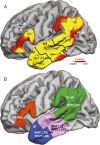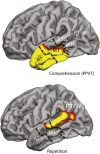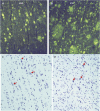Word comprehension in temporal cortex and Wernicke area: A PPA perspective
- PMID: 30578374
- PMCID: PMC6340389
- DOI: 10.1212/WNL.0000000000006788
Word comprehension in temporal cortex and Wernicke area: A PPA perspective
Abstract
Objective: To explore atrophy-deficit correlations of word comprehension and repetition in temporoparietal cortices encompassing the Wernicke area, based on patients with primary progressive aphasia (PPA).
Methods: Cortical thickness in regions within and outside the classical Wernicke area, measured by FreeSurfer, was correlated with repetition and single word comprehension scores in 73 right-handed patients at mild to moderate stages of PPA.
Results: Atrophy in the Wernicke area was correlated with repetition (r = 0.42, p = 0.001) but not single word comprehension (r = -0.072, p = 0.553). Correlations with word comprehension were confined to more anterior parts of the temporal lobe, especially its anterior third (r = 0.60, p < 0.001). A single case with postmortem autopsy illustrated preservation of word comprehension but not repetition 6 months prior to death despite nearly 50% loss of cortical volume and severe neurofibrillary degeneration in core components of the Wernicke area.
Conclusions: Temporoparietal cortices containing the Wernicke area are critical for language repetition. Contrary to the formulations of classic aphasiology, their role in word and sentence comprehension is ancillary rather than critical. Thus, the Wernicke area is not sufficient to sustain word comprehension if the anterior temporal lobe is damaged. Traditional models of the role of the Wernicke area in comprehension are based almost entirely on patients with cerebrovascular lesions. Such lesions also cause deep white matter destruction and acute network diaschisis, whereas progressive neurodegenerative diseases associated with PPA do not. Conceptualizations of the Wernicke area that appear to conflict, therefore, can be reconciled by considering the hodologic and physiologic differences of the underlying lesions.
© 2018 American Academy of Neurology.
Figures





References
Publication types
MeSH terms
Grants and funding
LinkOut - more resources
Full Text Sources
